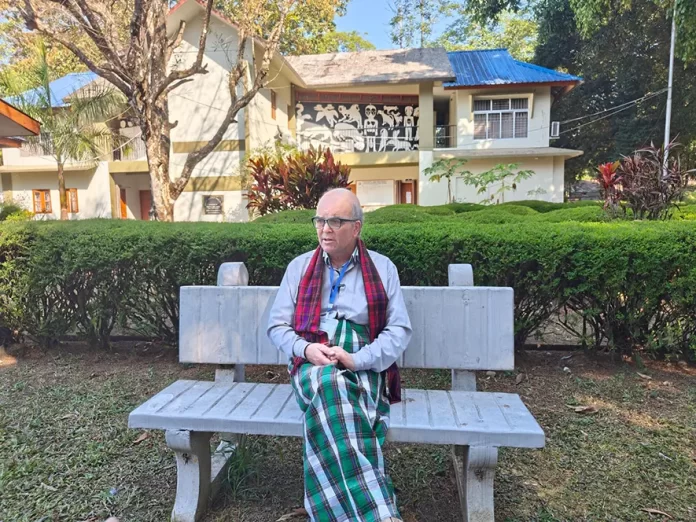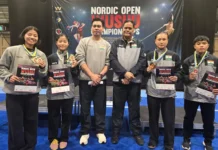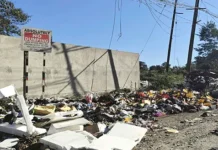Apasi Linggi, Kara Gambo, Tenjing Koyu & Indu Chukhu
ITANAGAR, 20 JAN: Dr Stephan Morey from La Trobe University has done extensive research on smaller often endangered languages, spoken on the India-Myanmar border covering four language groups: Tai, Singpho, Tangsa and Wancho. He also researches the Aboriginal languages of Victoria.
The Arunachal Times caught up with Dr Morey, who was in Rajiv Gandhi University in Rono Hills for a six-day international workshop on ‘Training and resources for indigenous community linguists (TRICL) organised by the Centre for Cultural-Linguistic Diversity (CCLD) and Arunachal Institute of Tribal Studies (AITS) that culminated on 18 January.
Question: What made you interested in documenting the languages of the tribal communities of the state?
Answer: Our university sent me on an exchange study in a university in the south of Thailand, called Pattani. One of the dialect teachers in the Tai language said, “You are going to India, so you should go to Assam and meet the Tai people there. I reached Assam in October, 1996 and started to study the Tai language. For a couple of years I studied Tai language exclusively in Assam because in those days protected area permit was difficult to obtain. Later, I came to learn about various tribes of the Northeast and I studied about the Singphos, who live in upper Assam and also in Changlang district. Eventually, I decided to add the study of Tangsa language with several groups of Tangsa people, and slowly I came to learn more and more. I became interested in studying as many languages as possible.
Q: How do you build trust with communities, and what approach did you take to reach out to those communities whose language you have documented?
A: In the beginning I didn’t know what would happen next, but I visited some villages of a community which is in Golaghat and Karbi Anglong districts of Assam, and then a few days later I went to Dibrugarh and met up with a member of the Tai Ahom community there. He agreed to take me to a village called Namphake or Namphakiyal. We attended a festival, and when we arrived there was no one in the village. They got one villager who had been an English teacher and suggested that we stay in his house, and we did that.
We were there for the festival, and at the end of the festival I had some suggestions for my host. I said, Look, I have learnt how to make a computer font for typing in the computer. I used the phrase ‘computer printing block’ because the word font was not known to them.
I asked, Would it be useful for your community if we make one for your Tai script? Accordingly, a meeting was organised with the village elders in the temple the next morning.
I learnt slowly that if you are going to come and study the languages of these communities, you have to give something back. The first thing I was able to do was to make this font in 1997. It was not particularly good, but really, till this day people are using it because it was easy to use and was accessible.
I don’t claim that I’ve always done things perfectly because in the early days, you would make recordings. For example, if it was video or cassette, they weren’t digital recordings and it has taken me a long time to get them into a digital format, so that I can share them back again. The work is still ongoing.
Q: How have you managed the complexities of documenting the diverse Tangsa dialects and what makes the diversity so significant?
A: Firstly I studied Tai languages, then I studied the Singhpos, where there is diversity but not to the same extent. The Tai Khamti and the Tai Phake (whose language I learnt and is the subject of my PhD) can understand each other basically 100 percent. Within the Tangsa, I slowly came to learn after 2007 that it is not one language but many; how many we can’t really say because it really depends on how you define what a separate language is.
Q: Based on your experience, what measures have proven most effective in ensuring the long-term sustainability of language revitalisation initiatives among the Tangsa and other indigenous groups? Can you share some examples where initial successes faced challenges over time, and how those challenges were addressed to maintain momentum in language preservation?
A: I think the most important thing to say about language preservation is that foreign scholars like me cannot preserve the language. The things I can do are make recordings. When I started in 1996, people were did not have access to recordings the way I do, so when I brought a video camera in 1999, people had never seen that type of thing, or a laptop.
Based on my experience, I can teach people what I have learnt and I can make these recordings and put them in a safe place where they can be accessed in the future. When it comes to preservation of language, this has to be come from the community itself. (The interview is divided into two parts with the second part of the interview slated for Wednesday’s edition)



